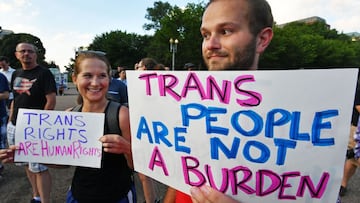What has Biden said about the Pentagon banning transgender people in the military?
President Biden fulfilled a campaign promise on Monday overturning a ban on transgender people serving in the US military imposed by former President Trump.

In 2017 former president Donald Trump declared via tweet that transgender service members would not be allowed to serve in the US Armed Forces. Due to legal challenges, it took two years before the ban could be imposed when the Supreme Court ruled 5-4 in the administrations favor. Now President Joe Biden has begun the reversal of that policy with an executive order.
The reversal has been greeted with applause by LGBTQ advocates that fulfills a campaign promise then candidate Joe Biden made. Joe Biden has openly been a champion of transgender rights since speaking on the issue in 2015 to the Human Rights Campaign, a gay rights group, calling it “the civil rights issue of our time.” On Twitter after signing the order he said “It’s simple: America is safer when everyone qualified to serve can do so openly and with pride.” It will take between 30 and 90 days for the Pentagon to reverse the ban.
Integration in the US Armed Forces
The US military over the years has overcome prejudices present in society to integrate more of society into its ranks. The main argument against integrating formerly unaccepted portions of society into the armed forces has been unit cohesion and operational readiness. But time and again the US military has integrated new members into the regular ranks with little or no problem.
In 1948, President Truman signed the Women’s Armed Services Integration Act into law allowing women serve as full, permanent members in all of the branches of the military. That same year Truman signed Executive Order 9981 abolishing discrimination "on the basis of race, color, religion or national origin" in the US Armed Forces integrating units.
Transgender individuals banned from the military
LGBTQ individuals however were banned from military service until President Clinton signed the controversial “Don’t Ask, Don’t Tell” in 1993. Only closeted gay, lesbian or bisexual people could serve and not be discriminated against. President Obama ended that policy in 2011 allowing openly gay, lesbian and bisexual individuals to serve, but transgender people were left out. But in 2014 the then Defense Secretary Chuck Hagel called for a review of the policy saying that “Every qualified American who wants to serve our country should have an opportunity if they fit the qualifications and can do it.”
Hagel’s successor Ashton Carter announced the following year that the Pentagon would move to allow transgender people to serve openly. Carter commissioned a study carried out by the RAND Corporation into allowing transgender people to serve openly. The findings stated that “the number [of transgender people serving openly] would likely be a small fraction of the total force and have minimal impact on readiness and health care costs.” The policy was implemented in June 2016.
President Trump bans transgender individuals in the military
After taking office President Trump surprised the Pentagon including all the members of the Joint Chiefs of Staff when he tweeted in July, 2017 “After consultation with my generals and military experts, please be advised that the United States government will not accept or allow transgender individuals to serve in any capacity in the U.S. military.” He argued “Our military must be focused on decisive and overwhelming victory and cannot be burdened with the tremendous medical costs and disruption that transgender in the military would entail.”
The Pentagon’s ban on transgender men and women enlisting in the military was met with lawsuits delaying its implementation until April 2019.
The real cost of transgender service members
There are no official figures on the number of transgender members in the US Armed Forces but the Rand report estimated between 1,320 and 6,630 out of a total of about 1.3 million service members were transgender in 2016. between July 1, 2016 and February 1, 2019, the Defense Department treated 1,525 service members who were diagnosed with gender dysphoria, a condition of extreme distress from not identifying with one’s biological gender.
The Rand report calculated that transgender-related healthcare for active-duty military would cost anywhere between $2.4m to $8.4m per year. In the three years before the ban went into effect the military spent about $8 million on transgender care out of a $50 billion overall budget according to data from the Defense Department provided to the House Armed Services Committee. Far from the billions that President Trump had claimed.
His other argument that transgender service members disrupted unit cohesion has been rebuked by uniformed leaders of all the military services in recent years telling lawmakers that they had seen no evidence of the sort.
Sumarios






